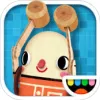Take a look inside 3 images
Toca Builders
Pros: It's easy and fun for kids to create.
Cons: Options for cooperative play are missing.
Bottom Line: Fun, engaging, open-ended play can work in a variety of content areas.
Math teachers can use Toca Builders to explore area and perimeter. Language arts teachers can use it for descriptive writing, where kids can write instructions for how to create a structure, or to complement story writing, either to illustrate stories or as a pre-writing activity for students to create worlds. Creative content areas can incorporate the game to give kids an opportunity to create using technology, building engagement, confidence, and tech skills.
Toca Builders is a sandbox-style building app in the vein of Minecraft, designed for kids ages 5 to 11. Play starts with a flat world floating on water. Kids control six different builders, each with a different job, to design whatever worlds they can imagine. One builder paints the ground. Another drops blocks from a backpack or destroys them with a hammer. A crane places blocks in high places, and a jumper hops up and places blocks. Another painter spits paint, and one builder stretches and places blocks in midair. Different builders can destroy blocks, too -- but not in an antagonistic way -- just to help create the world that kids imagine. Some characters move directionally using a gear-like shifter. Some move using a roller ball. Switching back and forth can get a little confusing, but most of the other controls are easy to pick up and fun to play around with. It would be nice if all of the builders could enter the buildings created, but some are taller than six blocks -- the maximum number of blocks the game allows players to stack. There's no competition or objective in the open-ended creation game. It's like playing with LEGOs without having to store them.
Alongside Minecraft and other sandbox-style creation toys and games, Toca Builders holds its own. This game doesn't include the monsters, zombies, and fighting involved in Minecraft's survival mode, so it may be a better classroom alternative for exploring world creation. The builder characters will appeal to kids drawn to stories, and the open-ended creation possibilities put kids in charge of their fun. Creations are automatically saved, and kids can revisit them. The lack of individual profiles is a downside, however. Each world is automatically saved, but anyone could access the world and alter it, and there's no labeling or naming. Also, only one player can create worlds at a time. So, unlike in Minecraft, kids can't work cooperatively (or competitively) to create worlds.










